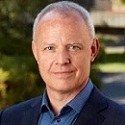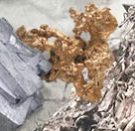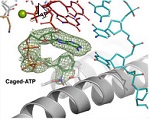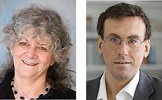Science Highlight
Copper and Zinc Forms in Bottom Ash from Solid Waste Incineration – Contacts: Charlotte Tiberg (Swedish Technical Institute), Carin Sjöstedt (Swedish University of Agricultural Sciences), and Karin Karlfeldt Fedje (Chalmers University of Technology)
When trash is burned for energy, a residue called bottom ash (BA) is left behind. Each year the European Union alone creates millions of tons of BA, which can be used for construction after treatment. It is concerning that BA may contain metals like copper and zinc that leach into the environment, potentially harming wild life and, people. The amount of these metals in the ash does not indicate whether the material is a potential hazard since these metals are more or less able to mobilize into the surrounding environment depending on factors like pH and the solubility of their chemical form. To better understand which chemical forms of copper and zinc exist in bottom ash and if there is much variation between different ashes, a team of scientists from Sweden analyzed six samples from different waste-to-energy plants using EXAFS on SSRL beamlines 4-1 and 4-3. Read more...
SSRL Research & Development
New Collaboration Aims to Bring Cutting-edge X-ray Methods to More Biological Researchers
Excerpt from SLAC News Article by Nathan Collins
Although synchrotron and x-ray free electron laser light sources have become some of the most valuable tools for studying biomolecular structure, they face many challenges – among them, the fact that x-rays can easily destroy proteins and other biological samples before scientists can get a good look at them.
It's a familiar story for researchers like Guillermo Calero, a structural biologist at the University of Pittsburgh who studies RNA polymerases, essential enzymes that read DNA and synthesize RNA as part of a process called transcription. While researchers knew a significant amount about the structure of human polymerases, the limitations of x-ray methods have hindered efforts to get a detailed picture of key parts of these structures, metals that catalyze biological reactions, or understand how they change during transcription.
Now, cases like Calero’s are driving a new, National Institutes of Health-funded effort at SSRL and LCLS to enable x-ray biomedical experiments that might not otherwise have been possible, make experiments more efficient, and ultimately to open up more opportunities for bioscientists to make use of the lab’s cutting-edge tools. Read more...
Researchers Discover Long-sought Mechanism behind Worst Cases of a Common Blood Disorder
Excerpt from SLAC News Article by Nathan Collins
With a name like glucose-6-phosphate dehydrogenase deficiency, one would think it is a rare and obscure medical condition, but that’s far from the truth. Roughly 400 million people worldwide live with potential of blood disorders due to the enzyme deficiency. While some people are asymptomatic, others suffer from jaundice, ruptured red blood cells and, in the worst cases, kidney failure.
Now, a team led by researchers led by Stanford/SLAC Prof. Soichi Wakatsuki has uncovered the elusive mechanism behind the most severe cases of the disease: a broken chain of amino acids that warps the shape of the condition’s namesake protein, G6PD. Read more...










